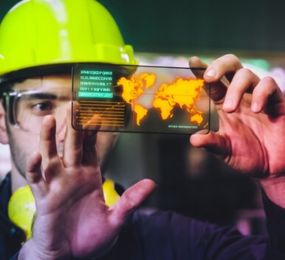Due to rapid technological advancement, the convergence of digitalization and Health, Safety, and Environment (HSE) practices is reshaping industries on a global scale. The profound impact of technology on the way we work and interact underscores the pivotal role it plays in the realm of HSE. This article embarks on an exploration of the evolving landscape of HSE in the digital age, shedding light on how digitalization is elevating safety measures, bolstering environmental conservation, and driving efficiency across sectors.
The ascendancy of digitalization has ushered in a new era characterized by a profusion of cutting-edge technologies, ranging from the Internet of Things (IoT) to Artificial Intelligence (AI) and the intricate world of Big Data analytics. These technological marvels are not merely transforming industries; they are also delivering innovative solutions to age-old HSE challenges.
Among the myriad advantages of digitalization in the realm of HSE, real-time monitoring stands as a beacon of progress. Within the framework of industrial operations, sensors and interconnected devices diligently gather data from diverse points. This data reservoir offers immediate insights into safety conditions and environmental parameters. For instance, in manufacturing plants, sensors adeptly detect hazardous conditions and can trigger automated shutdown protocols, substantially reducing risks to both workers and the environment.
Furthermore, the marriage of predictive analytics with AI algorithms empowers us with the capability to forecast potential safety issues. Through the meticulous analysis of historical data, AI discerns patterns that may precipitate accidents, equipment malfunctions, or environmental anomalies. Armed with this foresight, proactive measures can be initiated, thus averting accidents before they materialize.
Digitalization is a potent ally in the quest to enhance worker safety. Wearable devices equipped with a suite of sensors serve as guardian angels for the workforce. These devices are proficient in monitoring vital signs and environmental conditions. Should a worker's vital signs indicate distress or exposure to hazardous substances, the wearable device promptly dispatches an alert, facilitating rapid rescue missions.
Moreover, Augmented Reality (AR) and Virtual Reality (VR) technologies have found their niche in HSE training and simulations. Workers can partake in immersive safety training within a virtual environment, enabling them to navigate simulated hazards and challenges encountered in their professional roles.
Commitment to Environmental Sustainability
The marriage of digitalization and HSE extends its embrace to environmental conservation. IoT sensors and data analytics are the linchpins of real-time environmental monitoring. Industries can now scrutinize their environmental footprint in real-time, enabling timely responses to environmental incidents. For instance, in the oil and gas sector, sensors strategically placed in drilling operations can promptly detect oil spills or gas leaks, facilitating immediate containment measures.
Furthermore, digitalization lends unwavering support to the integration of renewable energy sources, a cornerstone of reducing carbon emissions. Smart grids, underpinned by digital technologies, adeptly optimize energy distribution, seamlessly incorporating energy harnessed from solar and wind sources.
As HSE regulations become increasingly stringent, digitalization provides an invaluable ally in ensuring compliance. Digital records offer transparency and auditability, simplifying the reporting process and assuring organizations that they meet regulatory standards.
However, as with any transformation, challenges accompany the promise of digitalization. Cybersecurity becomes paramount as organizations grapple with the collection and management of copious amounts of data. Additionally, cultivating specialized skills to manage digital HSE systems effectively becomes imperative.
The synergy between digitalization and HSE is poised to deepen as technology continues its relentless march forward. Organizations that embrace this transformation are not only fostering safer and more sustainable workplaces but also gaining a competitive edge in an increasingly digital world. The future of HSE is undeniably digital, and it promises improved safety, environmental stewardship, and operational excellence.
To register or learn more about the Forum please check here: https://www.leadventgrp.com/events/hse-excellence-for-energy-and-utilities/details
For more information and group participation, contact us: [email protected]
















